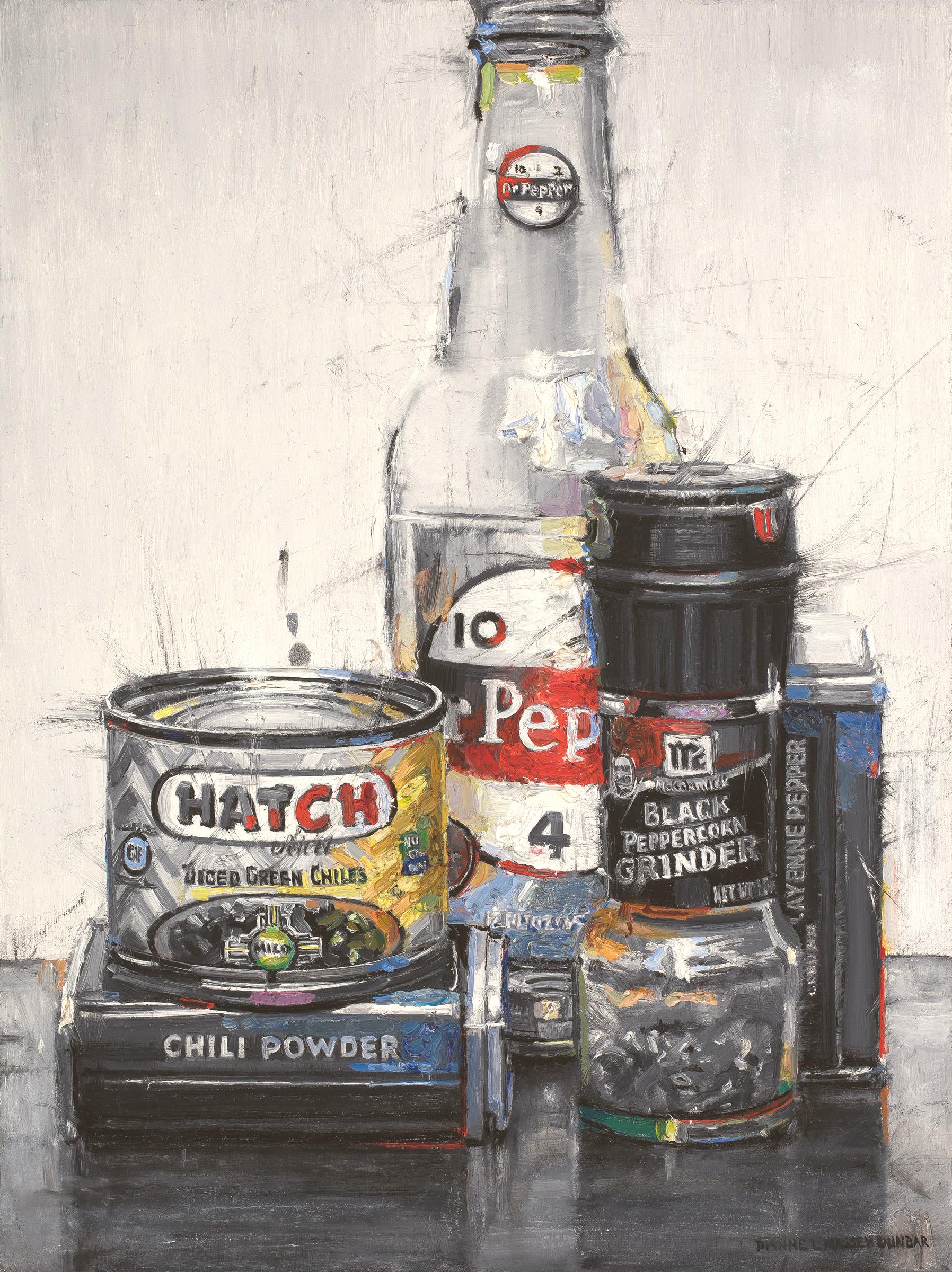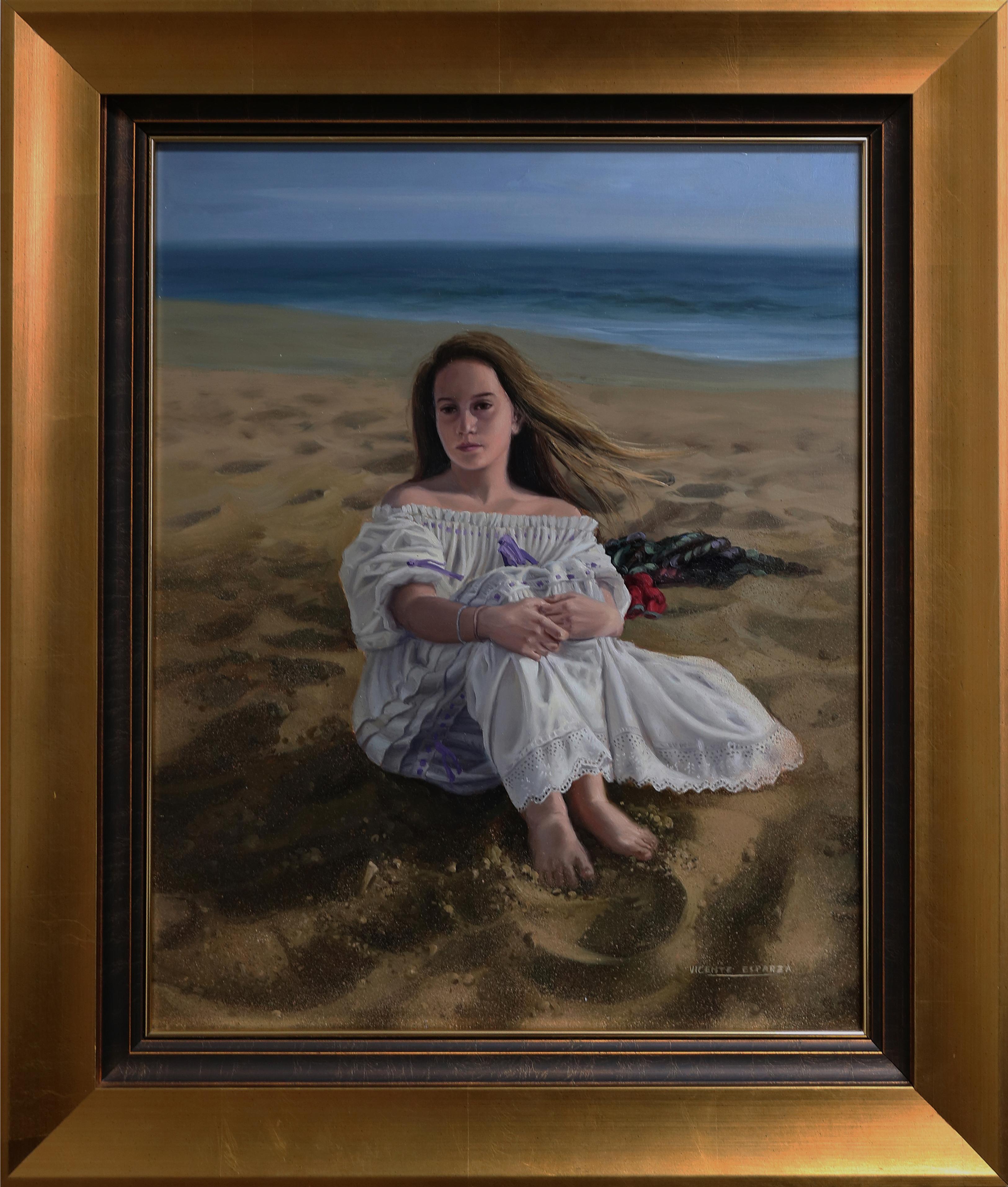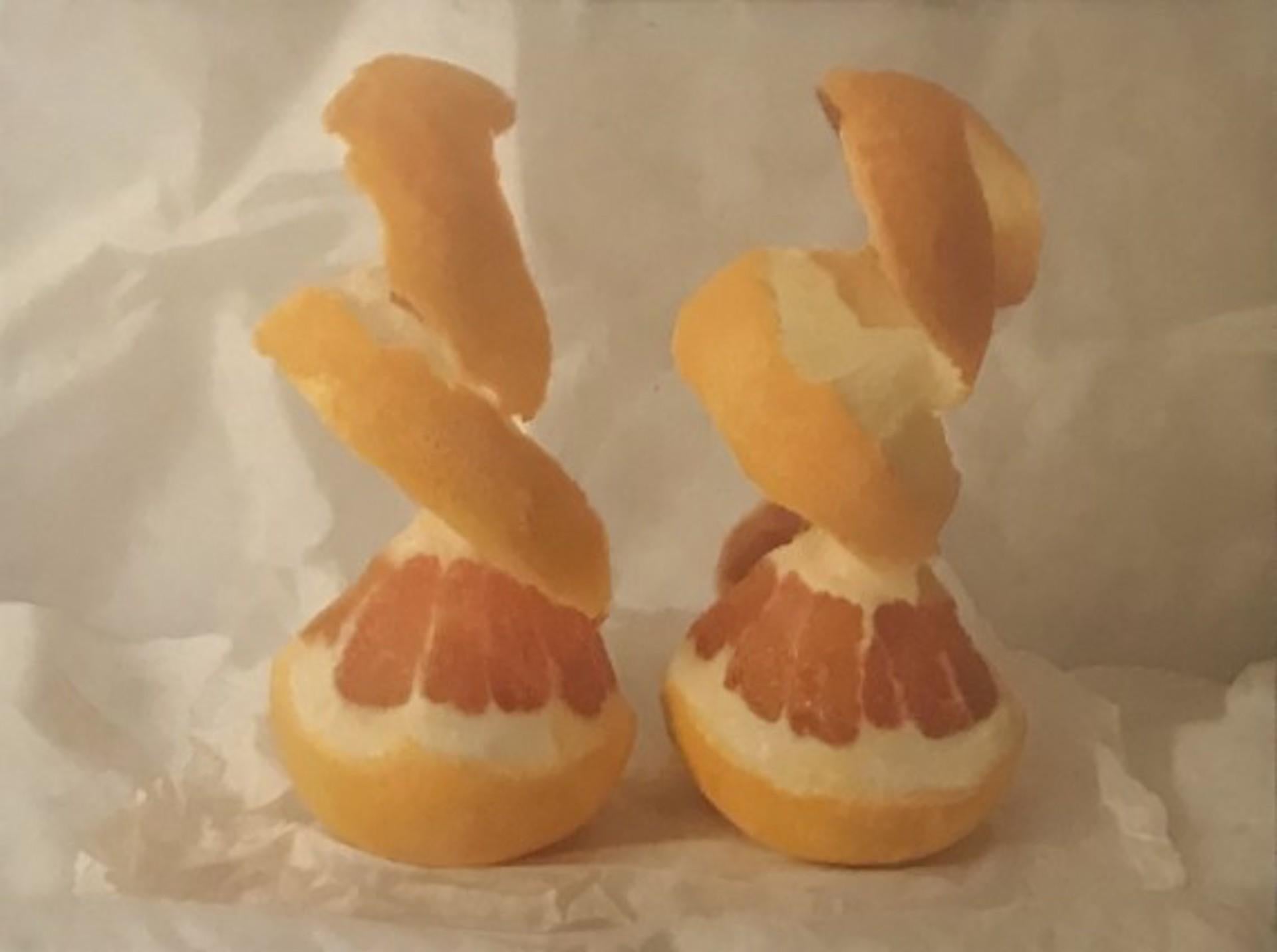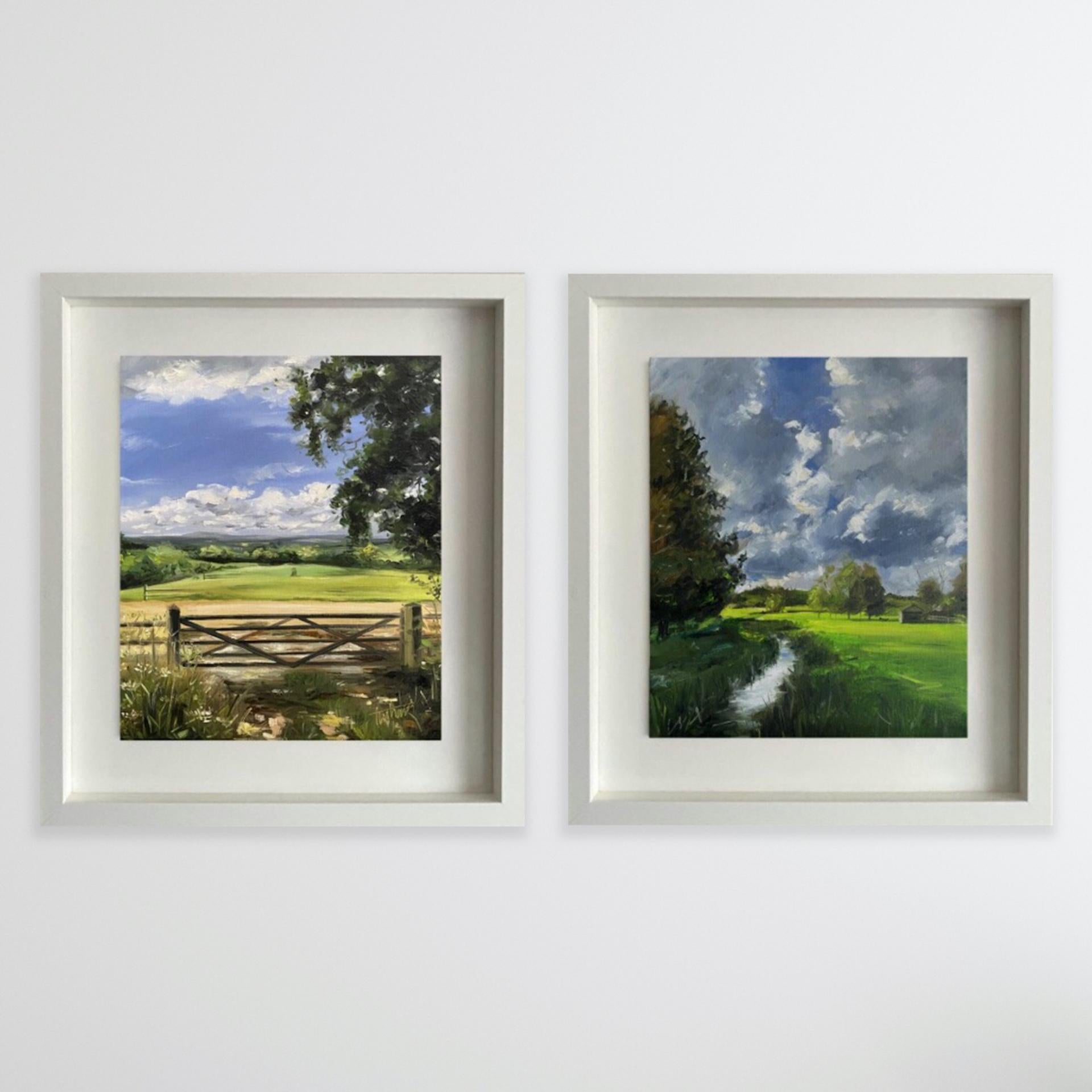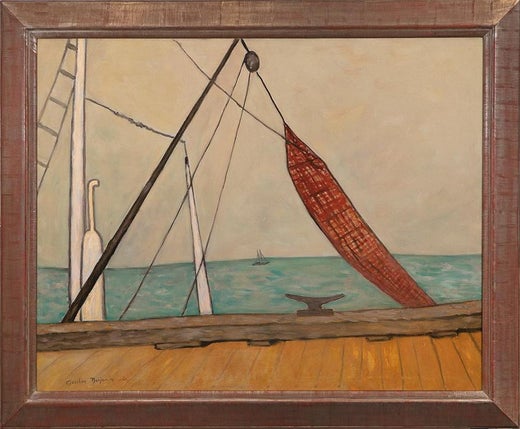Gershon Benjamin"Mother's Copper Bowl"c. 1959
c. 1959
About the Item
- Creator:Gershon Benjamin (1899, American)
- Creation Year:c. 1959
- Dimensions:Height: 20 in (50.8 cm)Width: 24 in (60.96 cm)
- Medium:
- Period:
- Condition:
- Gallery Location:Lambertville, NJ
- Reference Number:
Gershon Benjamin
In a body of work that spans seven decades, obscure American modernist artist Gershon Benjamin explored a varied range of tone, style and subject matter in watercolor, oil and charcoal. Not one to resign himself to a single trademark theme, Benjamin focused on an eclectic array of subjects. His paintings included landscapes, portraits, still lifes and urban scenes.
Benjamin was born in Romania just before the turn of the 20th century. His family moved to Montreal in 1901 to escape ethnic persecution. At 10, Benjamin began studying art at the Canadian Council of Arts and Manufacturers, in Quebec. When he was 12, the Royal Canadian Academy admitted Benjamin.
In 1923, Benjamin moved to New York City, where he secured a night job in the art department of The Sun newspaper. He also enrolled in the Art Students League, where he learned engraving from the notable lithographer Joseph Pennell and drawing from illustrator John Sloan.
Benjamin found inspiration in the work of Pablo Picasso and Paul Cézanne. He depicted urban life in meditative Expressionist paintings that later drew comparisons to the Ashcan School — Benjamin painted scenes of New York City’s blocky skyline, elevated subway trains, empty streets at dawn and the Brooklyn Bridge as he saw them on his way home from his night shift at the newspaper.
In New York, Benjamin forged friendships with creative people who were as in love with art as he was and painted with them in Gloucester, Massachusetts, during the city’s hot summers. A number of his acquaintances found a fair amount of fame — including artists Mark Rothko, Raphael Soyer and Milton Avery — whereas Benjamin sought none. And when artists of the era in Manhattan and elsewhere began to work in the style that would become known as Abstract Expressionism, Benjamin continued to create representational art. He remained largely obscure throughout his career, declining to promote or market his still lifes, landscapes and portraiture.
Benjamin's works are held in a number of private and public collections including the Pennsylvania Academy of Fine Arts and the Ulrich Museum of Art.
Find original Gershon Benjamin paintings on 1stDibs.
- ShippingRetrieving quote...Ships From: Lambertville, NJ
- Return PolicyThis item cannot be returned.
- "Gladioli Still Life"By Gershon BenjaminLocated in Lambertville, NJJim’s of Lambertville is proud to offer this artwork by: Gershon Benjamin (1899 - 1985) An American Modernist of portraits, landscapes, still lives, and the urban scene, Gershon ...Category
1950s Modern Still-life Paintings
MaterialsBoard, Oil
- "Still Life with Bananas"By Vaclav VytlacilLocated in Lambertville, NJJim’s of Lambertville is proud to offer this artwork by: Vaclav Vytlacil (1892-1984) He was born to Czechoslovakian parents in 1892 in New York City. Living in Chicago as a youth, he took classes at the School of the Art Institute of Chicago, returning to New York when he was 20. From 1913 to 1916, he enjoyed a scholarship from the Art Students League, and worked with John C. Johansen (a portraitist whose expressive style resembled that of John Singer Sargent), and Anders Zorn. He accepted a teaching position at the Minneapolis School of Art in 1916, remaining there until 1921. This enabled him to travel to Europe to study Cézanne’s paintings and works of the Old Masters. He traveled to Paris, Prague, Dresden, Berlin, and Munich seeking the works of Titian, Cranach, Rembrandt, Veronese, and Holbein, which gave him new perspective. Vytlacil studied at the Royal Academy of Art in Munich, settling there in 1921. Fellow students were Ernest Thurn and Worth Ryder, who introduced him to famous abstractionist Hans Hofmann. He worked with Hofmann from about 1922 to 1926, as a student and teaching assistant. During the summer of 1928, after returning to the United States, Vytlacil gave lectures at the University of California, Berkeley, on modern European art. Soon thereafter, he became a member of the Art Students League faculty. After one year, he returned to Europe and successfully persuaded Hofmann to teach at the League as well. He spent about six years in Europe, studying the works of Matisse, Picasso, and Dufy. In 1935, he returned to New York and became a co-founder of the American Abstract Artists group in 1936. He later had teaching posts at Queens College in New York; the College of Arts and Crafts in Oakland, California; Black Mountain College in North Carolina; and the Art Students League. His paintings exhibit a clear inclination toward modernism. His still lives and interiors from the 1920s indicate an understanding of the art of Cézanne. In the 1930s, his works displayed two very different kinds of art at the same time. His cityscapes and landscapes combine Cubist-inspired spatial concerns with an expressionistic approach to line and color. Vytlacil also used old wood, metal, cork, and string in constructions, influenced by his friend and former student, Rupert Turnbull. He eventually ceased creating constructions as he considered them too limiting. The spatial challenges of painting were still his preference. During the 1940s and 1950s, his works indicated a sense of spontaneity not felt in his earlier work. He married Elizabeth Foster in Florence, Italy, in 1927 and they lived and worked in Positano, Italy for extended periods of time. Later on, they divided their time between homes in Sparkill, New York and Chilmark, Massachusetts, where Vyt, as he was affectionately called, taught at the Martha's Vineyard Art...Category
1930s Abstract Expressionist Abstract Paintings
MaterialsOil, Board
- "Flowers and Fruit"By Mercedes MatterLocated in Lambertville, NJJim’s of Lambertville is proud to offer this artwork by: Mercedes Matter (1913 - 2001) Best known as a painter of abstract still life and founder of the New York Studio School, M...Category
20th Century Abstract Abstract Paintings
MaterialsCanvas, Oil
- "Red Tulips, Paris"By Bror Julius Olsson NordfeldtLocated in Lambertville, NJJim’s of Lambertville is proud to offer this artwork by: Bror Julius Olsson “B.J.O.” Nordfeldt (1878 – 1955) Bror Julius Olsson was born in Tullstrop, Sweden in 1878. He immigrated to the United States in 1891, later adopting his mother’s maiden name of Nordfeldt. Beginning his art studies at the Art Institute of Chicago where he was chosen to assist fellow artist, Albert Herter, with a large mural project for the McCormick Harvester Company. In 1900, he was sent to Paris by McCormick to help set up the completed mural at the Paris Exposition. While there, he studied briefly at the Academie Julian before traveling to England to study woodblock printmaking under F. Morley Fletcher. Returning to Chicago in 1903, Nordfeldt would spend the next ten years painting mainly figurative works in an academic style similar to that of the Old Masters. By the mid-teens he had developed a bold dramatic modernist style and divided his time between New York and Provincetown, Massachusetts. There, he invented the “Provincetown Print...Category
1930s American Modern Still-life Paintings
MaterialsCanvas, Oil
- "Bottle & Glasses"By James LechayLocated in Lambertville, NJJim’s of Lambertville is proud to offer this artwork by: James Lechay (1907 – 2001) Born in the Bronx in 1907, James Lechay spent most of his childhood in Brooklyn before moving to Joilet, Illinois at age 13 to live with his uncle after his mother passed away. In 1928, he received his B.A. in psychology from the University of Illinois. The next year, he attended one week of graduate school before leaving to study under his brother, the painter Myron Lechay, in New York. At his brother’s studio, James began to associate with other artists of the time such as Milton Avery, Mark Rothko, Arshile Gorky, William Zorach, and Raphael and Moses Soyer. From Myron, James Lechay learned to train his eye to observe natural forms and developed a philosophy dependent upon the relationship built between the artist and the subject. Lechay became engaged in the social and political issues of Depression-era New York and even joined the social realism movement for a brief time in the 1930s. He operated as the leader of the Artists Union while employed by the Works Progress Administration (WPA). With the WPA, Lechay traveled to Las Vegas, New Mexico, where he established a gallery and exhibited the works of Milton Avery, Max Weber, and other WPA artists. Despite his association with many artists and artistic communities in New York in the 1930s and 40s, Lechay opposed adopting a style due to its popularity and commercial success. His use, however, of large brushstrokes from Abstract Expressionism, the flattened plane of Modernism, and the simple compositions of early Abstraction created a combination of styles completely his own. A painter of a vast range of subjects, including still lifes, portraits, and landscapes, Lechay was known to reduce these forms to their visual essentials. Lechay often did not date his paintings as he frequently reworked them, even after they were exhibited, calling his pieces, “finished at all stages and never finished”. In 1945, Lechay was hired by the University of Iowa’s art department, where he worked alongside Mauricio Lasansky, Humbert Albrizio, Carl Fracassini, and Byron Burford...Category
20th Century Abstract Abstract Paintings
MaterialsCanvas, Oil
- "Pink Vase with Flowers"By James LechayLocated in Lambertville, NJJim’s of Lambertville is proud to offer this artwork by: James Lechay (1907 – 2001) Born in the Bronx in 1907, James Lechay spent most of his childhood in Brooklyn before moving to Joilet, Illinois at age 13 to live with his uncle after his mother passed away. In 1928, he received his B.A. in psychology from the University of Illinois. The next year, he attended one week of graduate school before leaving to study under his brother, the painter Myron Lechay, in New York. At his brother’s studio, James began to associate with other artists of the time such as Milton Avery, Mark Rothko, Arshile Gorky, William Zorach, and Raphael and Moses Soyer. From Myron, James Lechay learned to train his eye to observe natural forms and developed a philosophy dependent upon the relationship built between the artist and the subject. Lechay became engaged in the social and political issues of Depression-era New York and even joined the social realism movement for a brief time in the 1930s. He operated as the leader of the Artists Union while employed by the Works Progress Administration (WPA). With the WPA, Lechay traveled to Las Vegas, New Mexico, where he established a gallery and exhibited the works of Milton Avery, Max Weber, and other WPA artists. Despite his association with many artists and artistic communities in New York in the 1930s and 40s, Lechay opposed adopting a style due to its popularity and commercial success. His use, however, of large brushstrokes from Abstract Expressionism, the flattened plane of Modernism, and the simple compositions of early Abstraction created a combination of styles completely his own. A painter of a vast range of subjects, including still lifes, portraits, and landscapes, Lechay was known to reduce these forms to their visual essentials. Lechay often did not date his paintings as he frequently reworked them, even after they were exhibited, calling his pieces, “finished at all stages and never finished”. In 1945, Lechay was hired by the University of Iowa’s art department, where he worked alongside Mauricio Lasansky, Humbert Albrizio, Carl Fracassini, and Byron Burford...Category
1990s Abstract Abstract Paintings
MaterialsCanvas, Oil
- 1920's Pink & Blue Impressionist Floral Still-Life Early Work Society of SixBy William ClappLocated in Soquel, CAA brilliant early 20th century impressionist floral still-life by William Clapp (American, 1879-1954). Beautiful and bold, this 1920's pink floral still-life pops against a bright blue background. The artist uses expressive and loose brushstrokes in a fun and energetic palette, bringing a dynamic and lively energy to this one-of-a-kind piece. Signed lower right, "W. Clapp". Oil on old Canada packing crate board and presented in a rustic wood frame. Board size: 20"H x 24"L. Framed size: 24"H x 28"W. This an early work by the artist which is distinctive in his bold Impressionist style before he merged into his signature pointillist style. Born in Montreal, Canada of American parents on Oct. 29, 1879. At age six Clapp moved to California with his family, settling in Oakland where he spent his childhood. In 1900 he returned to Montreal for four years of study with Wm Brymner followed by further study in Paris at Académies Julian, Colarossi, and Grande Chaumière. He then returned to Montreal where he was elected an associate member of the Royal Canadian Art Academy. He lived and worked in Cuba before returning to Oakland in 1917. He then served as director and curator of the Oakland Art Gallery from 1918-49. In this position, and as a member of a group of painters called the Society of Six...Category
1920s American Impressionist Still-life Paintings
MaterialsBoard, Oil
- Mediterranean still life Spain oil painting spanishBy Rafael Duran BenetLocated in Barcelona, BarcelonaRafael Duran Benet (1931-2015) - Still life - Oil Oil on canvas glued to board. Measures work 46x55 cm. Frameless. Rafael Duran Benet (Terrassa, 1931 - Barcelona, 2015) is a Catalan...Category
Early 2000s Post-Impressionist Still-life Paintings
MaterialsCanvas, Oil, Board
- Still Life - Oil on Canvas - Late 19th centuryLocated in Roma, ITStill Life is an artwork realized by an unknown artist in the late 19th Century. Oil on Canvas Mounted on Board. 18 x 13 cm. Good conditionsCategory
Late 19th Century Modern Still-life Paintings
MaterialsOil, Board, Canvas
- Still Life - Oil on Canvas - Late 19th centuryLocated in Roma, ITStill Life is an artwork realized by an unknonwn artist in the late 19th Century. Oil on Board. 21 x 15 cm. Good conditionsCategory
Late 19th Century Modern Still-life Paintings
MaterialsOil, Board, Canvas
- Viktor Ivanovich Kalashnikov 'Still Life with Radishes and Onions' PaintingLocated in San Rafael, CAViktor Ivanovich Kalashnikov (Russian, 1923 - 1992) Still life with Radishes and Onions Oil on board Signed 'VIK', lower left 12" H x 19" W In a carved gilt frame: 17.25" H x 24.25"...Category
Early 20th Century Post-Impressionist Still-life Paintings
MaterialsOil, Board
- Forest river. 1990. Cardboard, oil. 67, 5x93 cmBy Edgars VintersLocated in Riga, LVForest river. 1990. Cardboard, oil. 67,5x93 cm Information about artist Edgars Vinters (1919-2014). Edgars Vinters was working in oil, waterc...Category
1990s Impressionist Landscape Paintings
MaterialsOil, Cardboard
